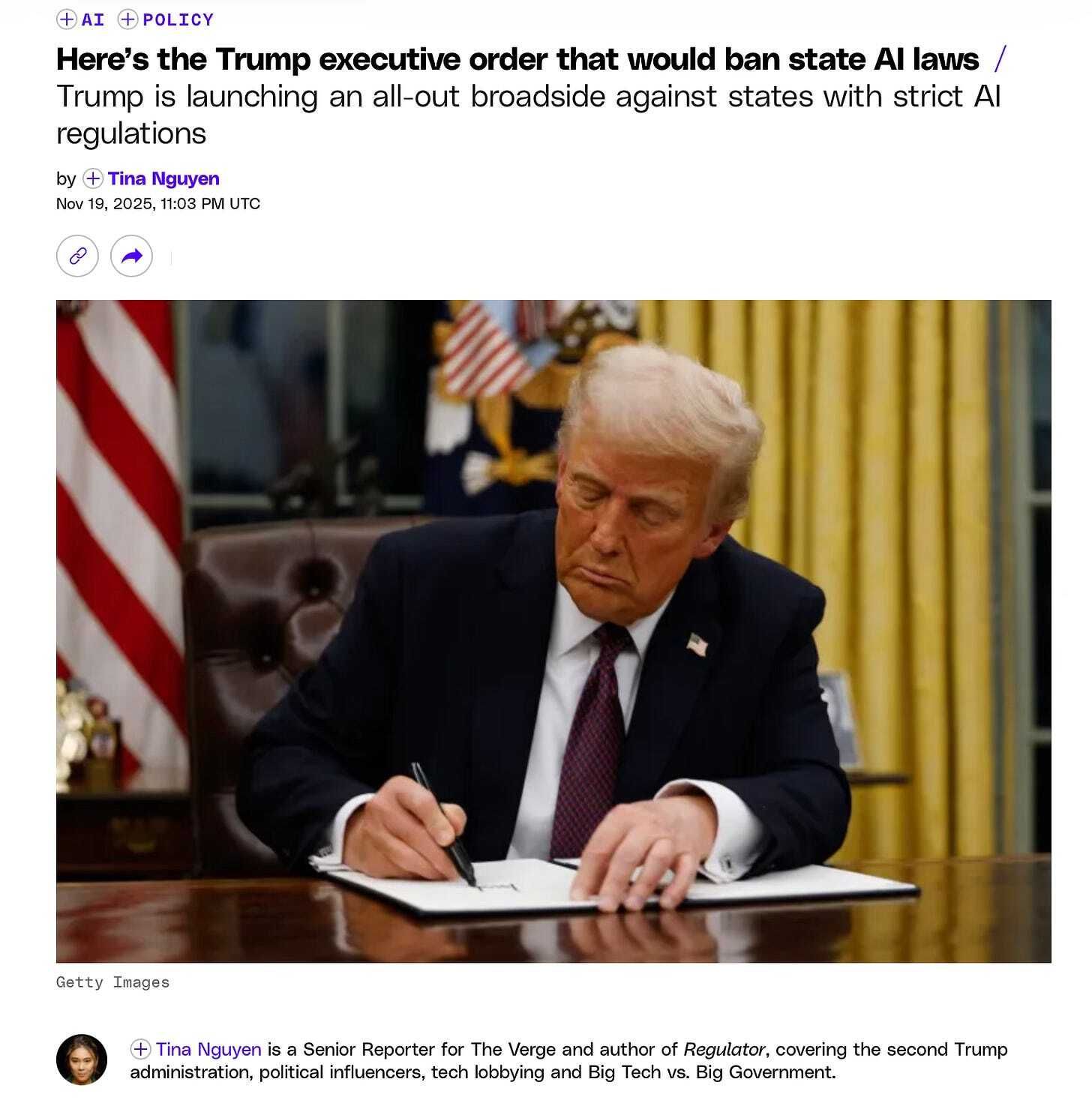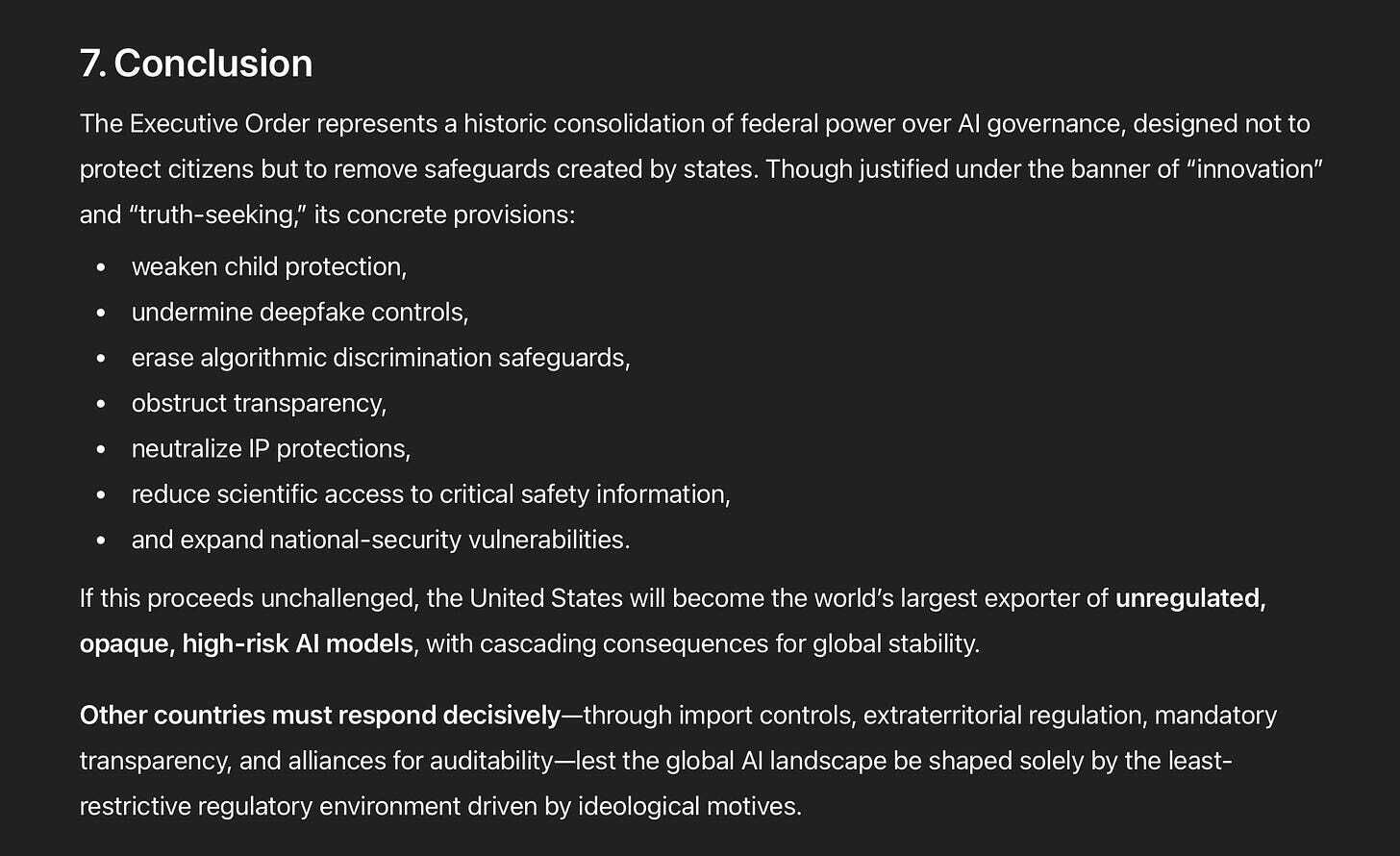- Pascal's Chatbot Q&As
- Posts
- Trump preempting, nullifying, or discouraging all state-level AI laws, backed by litigation threats, conditioning of federal funding, reinterpretation of FCC/FTC powers & a future federal statute...
Trump preempting, nullifying, or discouraging all state-level AI laws, backed by litigation threats, conditioning of federal funding, reinterpretation of FCC/FTC powers & a future federal statute...
...to solidify preemption. This reveals a strategic ideological consolidation of AI governance. For society at large, the consequences are overwhelmingly negative.
A Federal Takeover of AI Regulation: Implications, Risks, and Global Lessons
by ChatGPT-5.1
The draft Executive Order reveals one of the most consequential policy shifts of the decade aimed at preempting, nullifying, or discouraging all state-level AI laws, backed by litigation threats, conditioning of federal funding, reinterpretation of FCC/FTC powers, and a future federal statute to solidify preemption.
The EO establishes a powerful AI Litigation Task Force to challenge state laws; orders the Department of Commerce to label “onerous” state AI statutes; conditions broadband funding (BEAD) on repeal of state AI rules; and directs federal regulators to create a uniform federal disclosure and reporting standard. It explicitly targets laws requiring safety evaluations, transparency, deepfake provenance tracking, algorithmic discrimination protections, and other risk-mitigation measures.
Paired with the political narrative in the The Verge article—which frames this as a fight against “woke AI,” DEI requirements, and “catastrophic risk” safeguards—this reveals not merely a regulatory alignment effort, but a strategic ideological consolidation of AI governance.
The central question: Is this development positive or negative?
The answer depends entirely on whose interests one values—but for society at large, the consequences are overwhelmingly negative.
1. What the Executive Order Does
1.1. Establishes a litigation machine to crush state AI laws
Within 30 days, DOJ must create a dedicated task force “whose sole responsibility shall be to challenge State AI laws”. States can expect constant lawsuits claiming:
violations of interstate commerce,
unlawful burdens on national innovation,
unconstitutional compelled speech,
conflict with federal priorities.
1.2. Identifies “onerous” state AI laws for federal targeting
The Secretary of Commerce must publish a list of state laws deemed obstructive, especially those requiring:
model disclosures,
risk assessments,
safety reports,
mitigation of discrimination,
transparency about catastrophic-risk research.
(E.g., California’s AI safety law; Colorado’s anti-algorithmic discrimination rule.)
1.3. Cuts federal funding to states that maintain such laws
States could lose access to BEAD broadband funds and other discretionary grants unless they repeal or suspend their AI protections. This is a powerful coercive tool.
1.4. Orders FCC, FTC, and Commerce to preempt state rules
Agencies are directed to reinterpret federal statutes broadly enough to override state authority, especially in the areas of:
disclosure requirements,
reporting standards,
algorithmic behavior,
consumer deception.
1.5. Plans a federal statute mandating uniform national AI rules
The EO orders preparation of legislation that would explicitly preempt all conflicting state AI laws.
2. Is This a Positive or Negative Development?
For society and democratic governance, this is overwhelmingly negative.
AI impacts child safety, elections, medical guidance, content integrity, IP rights, military systems, and scientific research. States—especially California, Colorado, New York, Washington—have taken the lead where federal policy lags or is captured by industry lobbyists.
The EO removes the only functioning regulatory layer currently addressing:
deepfake misuse,
algorithmic discrimination,
transparency obligations,
provenance and watermarking,
catastrophic-risk mitigations,
scientific model auditability,
consumer safety safeguards.
The move centralizes power in federal agencies that the administration openly intends to use to protect industry from safety and transparency requirements.
3. Consequences for Critical Areas
Below is a detailed analysis of how this policy affects core societal and technological domains.
3.1. Child Safety and Online Harms
State laws increasingly protect children from:
AI-generated sexual deepfakes of minors,
synthetic child abuse material,
algorithmic amplification of harmful content,
predatory AI agents masquerading as peers,
personalized grooming risks.
Many states (e.g., California, Virginia, Utah, New York) have introduced or passed bills requiring:
deepfake provenance tracking,
duty-of-care obligations,
rapid removal of harmful synthetic content involving minors.
The EO would nullify these protections.
A federal “minimally burdensome” standard—explicitly described as one preventing subjective safety requirements—would almost certainly:
remove state obligations to identify or mitigate grooming by AI agents,
block state civil actions enabling parents to sue companies that generate child deepfakes,
weaken obligations for watermarking or authenticity labeling,
hamper state-level law enforcement from acting on AI-generated sexual abuse content.
Net effect: a worsening of risks for children, with fewer tools to detect, prevent, or prosecute harms.
3.2. Deepfakes, Election Interference, and Authenticity
States have led on regulating deepfake political content—especially during elections. Several have:
banned deceptive synthetic political ads,
required disclosure labels,
mandated watermarking of political content,
criminalized malicious impersonation of candidates.
These protections would be deemed “onerous” because they:
require model output alterations,
require “disclosure and reporting”,
impose labeling mandates.
If preempted:
Election deepfake chaos becomes a certainty.
States will no longer be able to require notices on synthetic political content.
Local authorities lose the ability to prosecute impersonation meant to disrupt elections.
This creates a glaring national-security vulnerability.
3.3. Scientific Research and Model Transparency
California’s law requiring:
access to documentation on frontier model evaluations,
reporting of catastrophic-risk safety tests,
is explicitly cited in the Verge article as a target of federal suppression.
Consequences:
Researchers studying model alignment, interpretability, and catastrophic risk lose access to data.
Safety research becomes dependent on voluntary disclosures from labs with severe conflicts of interest.
Auditability disappears at the state level before any equivalent federal framework exists.
This harms:
academia,
safety institutes,
international researchers relying on U.S. transparency,
regulators abroad who depend on U.S. safety signals.
3.4. Intellectual Property Rights and Content Protection
States have begun experimenting with:
training-data transparency rules,
opt-out registries,
restitution obligations for scraped copyrighted content,
model-audit requirements to detect infringement.
The EO’s language about “compelled disclosures,” “truthful outputs,” and “onerous reporting” means these would be flagged as obstructive.
Consequences:
Rights holders (publishers, journalists, musicians, artists) lose state avenues to protect their work.
States cannot require information about training sets or derivatives.
Detection and auditability of infringement becomes nearly impossible.
Federal regulators have not proposed any alternative enforcement.
This hands AI labs a powerful shield to continue training on copyrighted material without consent or transparency.
3.5. Algorithmic Discrimination and Civil Rights
Colorado’s law prohibiting algorithmic discrimination is directly attacked in the EO and in the political messaging (portrayed as “DEI-embedding AI” or “woke AI”).
If preempted:
States lose the ability to prevent discriminatory outcomes in lending, housing, hiring, healthcare, criminal justice, and education algorithms.
A blunt federal standard replaces tailored civil-rights protections.
Individuals will have fewer rights to challenge discriminatory AI decisions.
This differential impact disproportionately harms marginalized communities.
3.6. Consumer Protection and AI Harm Liability
Many state efforts include:
duty-of-care protections,
transparency obligations,
nondiscrimination rules,
restrictions on manipulative AI.
These would be overridden before any national safety net exists.
Consumers would face:
lower safety,
fewer rights of recourse,
increased exposure to harmful AI-generated medical, legal, or financial guidance.
3.7. National Security and Geopolitical Positioning
Oddly, weakening state safety laws creates vulnerabilities:
More deepfake election interference (including from foreign actors).
Harder detection of AI-enabled fraud.
Easier proliferation of untested frontier systems.
Reduced oversight of synthetic biological models or dual-use systems.
The stated goal—“AI dominance”—conflicts with the national security consequences of unregulated frontier models.
4. International and Regulatory Implications
If this federal preemption proceeds, other countries will face profound consequences in transatlantic and global AI governance.
4.1. EU and UK
With states stripped of view-access obligations, the EU and UK lose:
visibility into training-data provenance,
safety evaluations,
catastrophic-risk reporting.
This undermines the EU AI Act’s ability to assess compliance for models entering the EU market.
4.2. Canada, Australia, Japan
They will face:
less cooperation from U.S. safety regulators,
more opaque U.S. models exported abroad,
competitive pressure to deregulate to match U.S. standards.
4.3. China
China may seize regulatory leadership, positioning itself as:
the global standard-setter in safety,
the leader in watermarking and content provenance,
the comprehensive regulator of high-risk models.
This would be a dramatic geopolitical shift.
5. What Should Other Countries and Regulators Do?
If the U.S. moves to outlaw state-level AI protections, foreign regulators must treat U.S. AI imports as potentially hazardous.
5.1. Implement strict import controls for AI systems
Require documentation for AI models entering the market.
Mandate transparency for training data used on foreign users.
Impose a duty of auditability for safety and IP rights.
5.2. Adopt international safety and transparency standards
This may include:
deepfake provenance requirements,
model-evaluation reporting,
child-safety obligations,
copyright-training disclosures,
risk-based licensing.
5.3. Create extraterritorial obligations
Mirroring the GDPR model:
foreign companies must comply with local safety rules to operate.
individuals retain rights over data, likeness, and outputs involving them.
5.4. Strengthen cross-border coalitions
For example:
EU-UK-Canada-Australia alignment on deepfakes and safety,
shared research infrastructure,
joint audit and testing facilities.
5.5. Require model provenance and watermarking
If the U.S. government blocks authenticity tracking, other states must require it on their territory.
6. What Happens If Regulators Do Nothing?
If other governments fail to act, the consequences are extreme:
6.1. Explosion of deepfake manipulation in elections
Foreign and domestic actors will exploit unregulated systems to produce undetectable political disinformation.
6.2. Unchecked frontier models accelerate risk
Without state-level oversight or mandatory evaluations, catastrophic-risk systems proliferate.
6.3. Total collapse of IP rights in training data
AI companies will continue to train on copyrighted and proprietary content—undetectably and without recourse.
6.4. Mass child-safety harms
More synthetic child abuse content, more grooming via AI agents, more realistic impersonation.
6.5. Discriminatory AI systems proliferate
Hiring, lending, housing, police algorithms will embed biases with no state guardrails.
6.6. Loss of public trust in AI
The absence of transparency or recourse will lead to:
institutional mistrust,
social instability,
political backlash,
further polarization.
6.7. Global regulatory fragmentation
If the U.S. retreats from regulation while others enforce strict rules, interoperability suffers. This hurts:
scientific research,
cross-border data flows,
corporate compliance,
public safety.
6.8. Concentration of power in a few AI firms
With states neutralized, only federal regulators—aligned with industry interests—control the rules. This accelerates:
monopolistic consolidation,
political capture,
suppression of smaller or safer-by-design competitors.
7. Conclusion
The Executive Order represents a historic consolidation of federal power over AI governance, designed not to protect citizens but to remove safeguards created by states. Though justified under the banner of “innovation” and “truth-seeking,” its concrete provisions:
weaken child protection,
undermine deepfake controls,
erase algorithmic discrimination safeguards,
obstruct transparency,
neutralize IP protections,
reduce scientific access to critical safety information,
and expand national-security vulnerabilities.
If this proceeds unchallenged, the United States will become the world’s largest exporter of unregulated, opaque, high-risk AI models, with cascading consequences for global stability.
Other countries must respond decisively—through import controls, extraterritorial regulation, mandatory transparency, and alliances for auditability—lest the global AI landscape be shaped solely by the least-restrictive regulatory environment driven by ideological motives.
If they do nothing, society faces a future of:
pervasive deepfakes,
weakened democratic institutions,
rampant IP violations,
unsafe frontier systems,
unchecked discrimination,
and escalating systemic risks.
In short, this EO is not a step toward responsible innovation—but a step toward regulatory voids that maximize industry freedom at the expense of public safety, democratic integrity, and the global rule of law.

